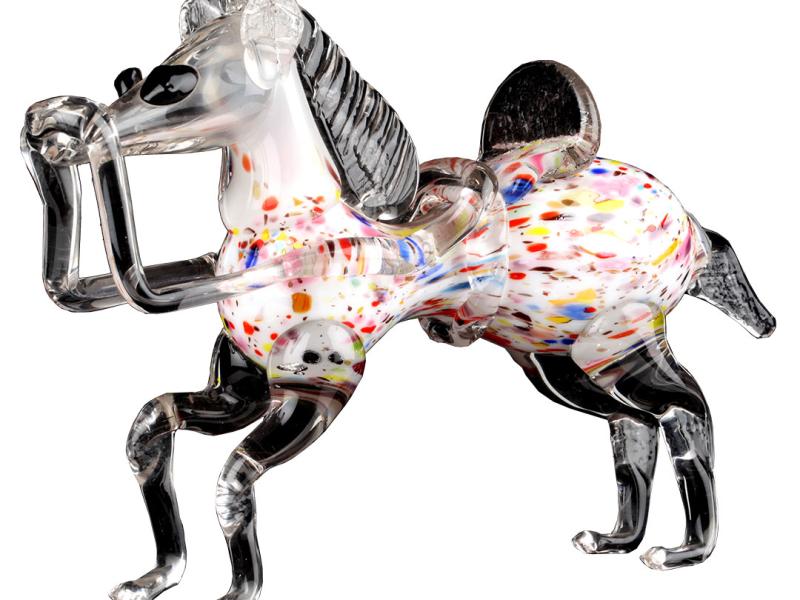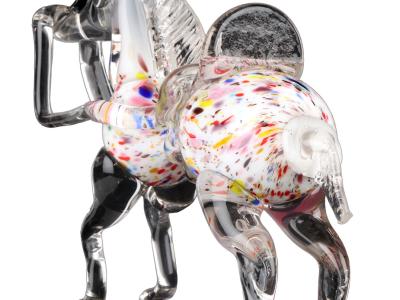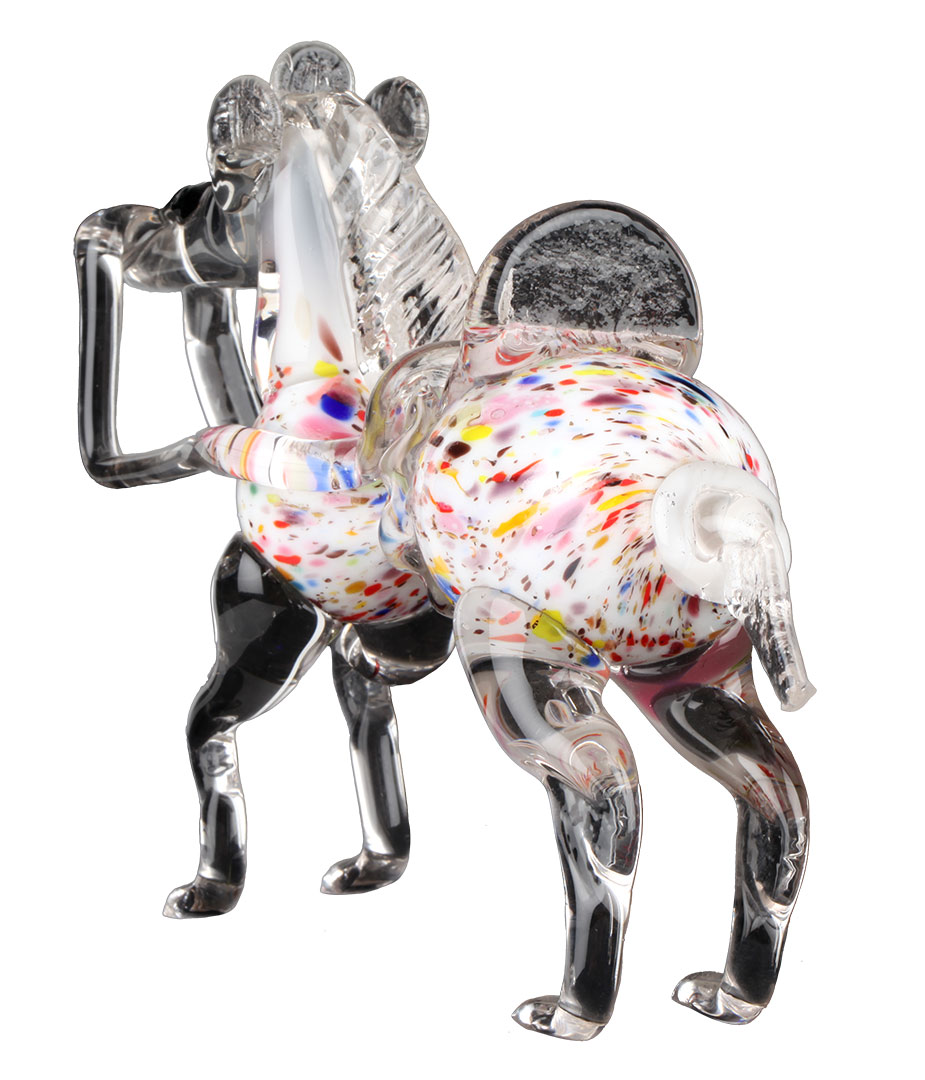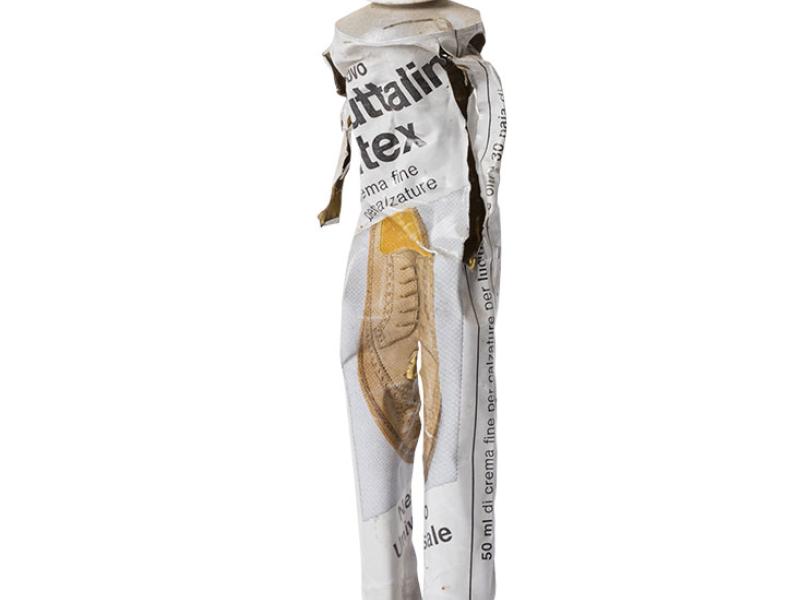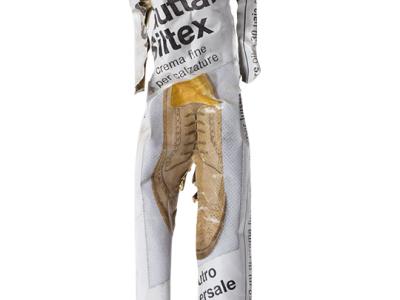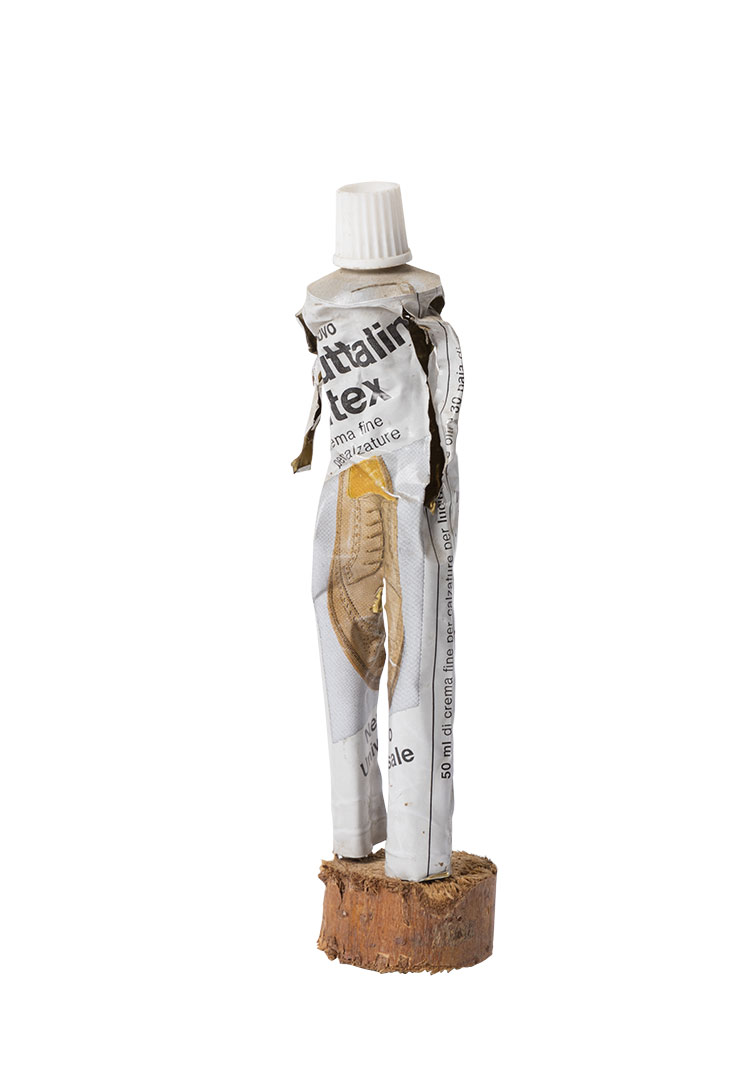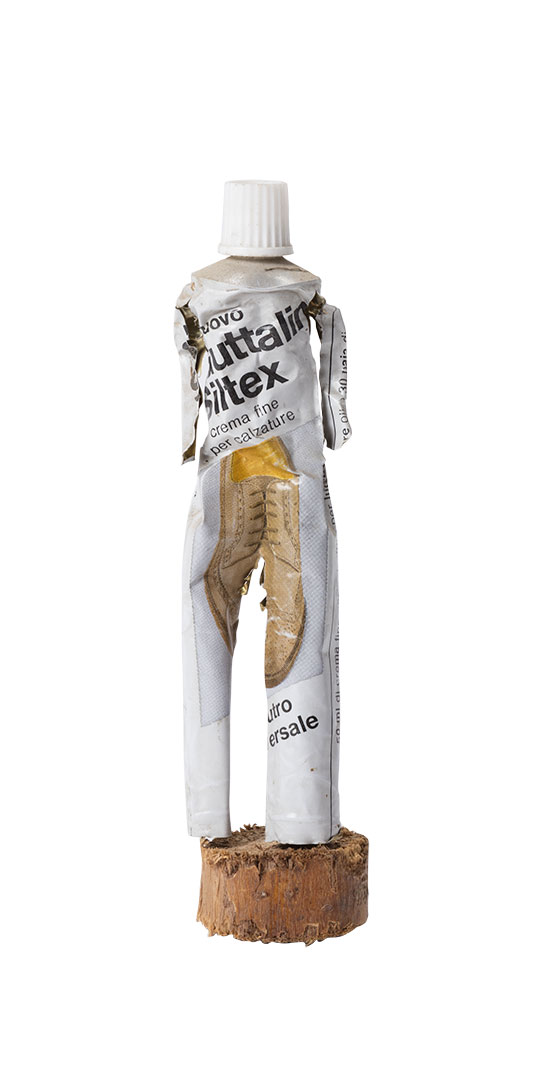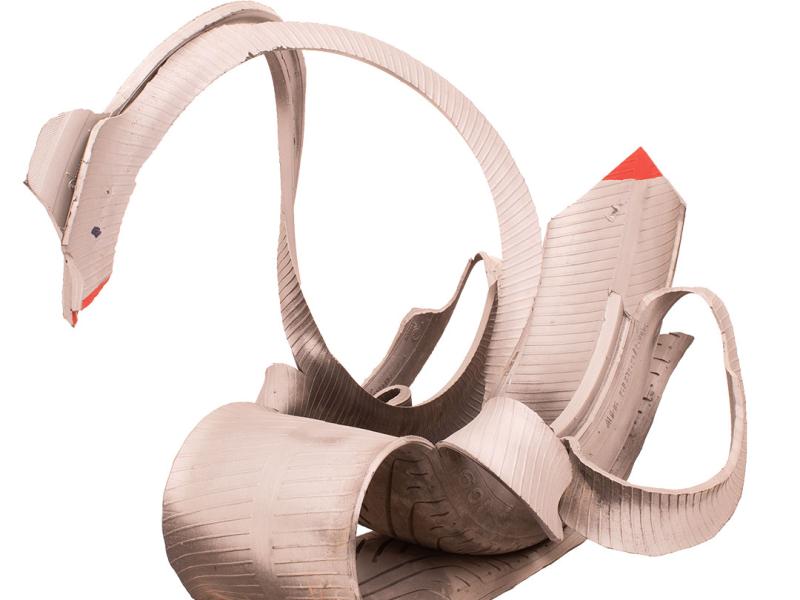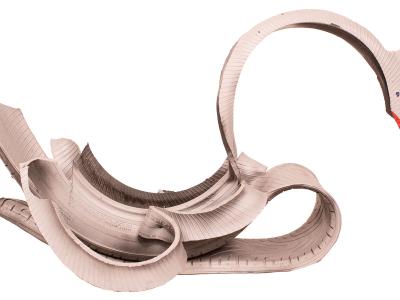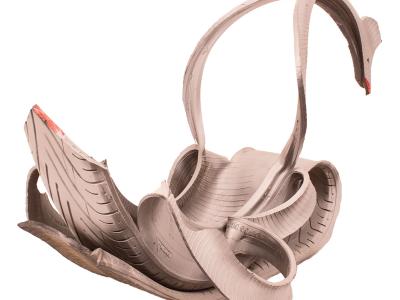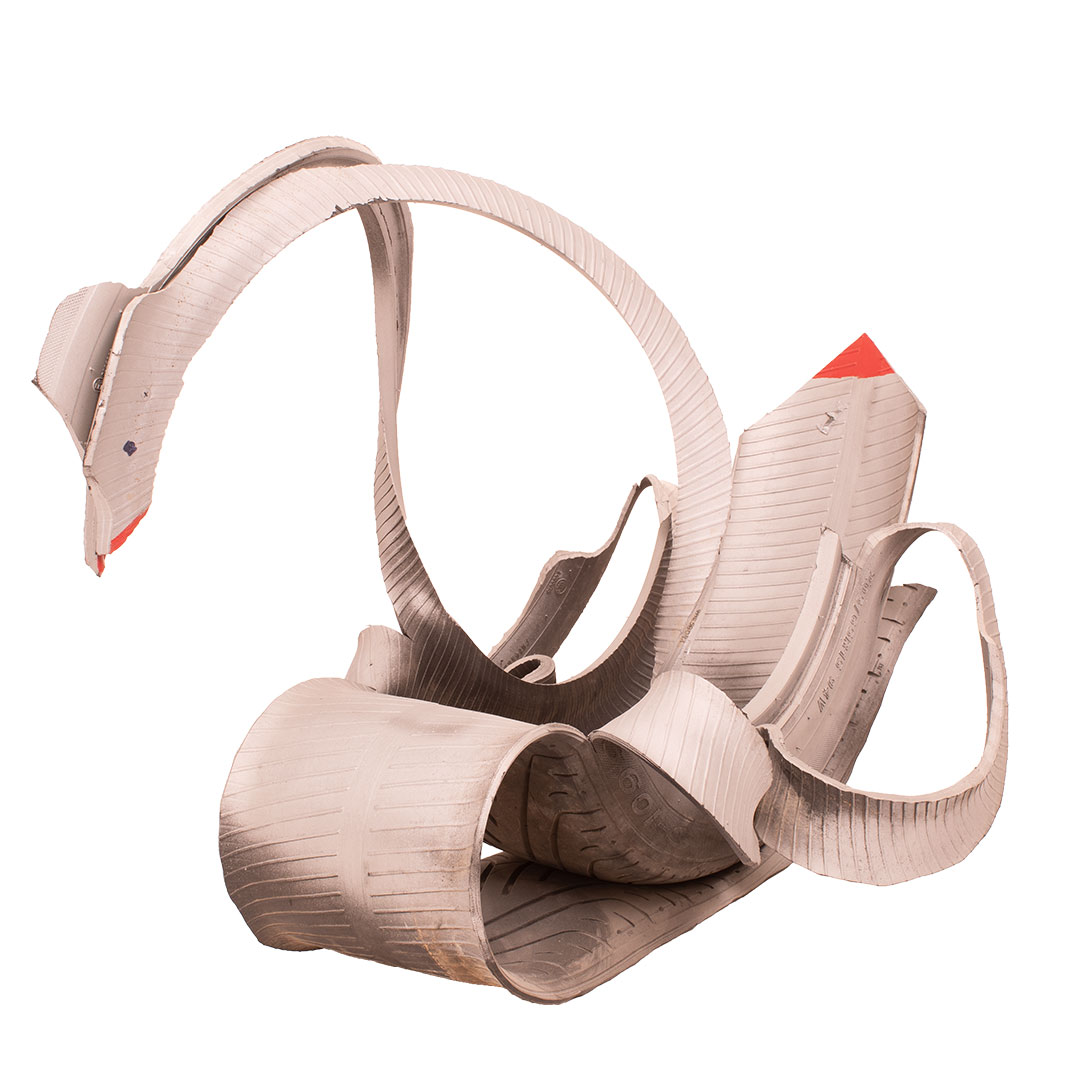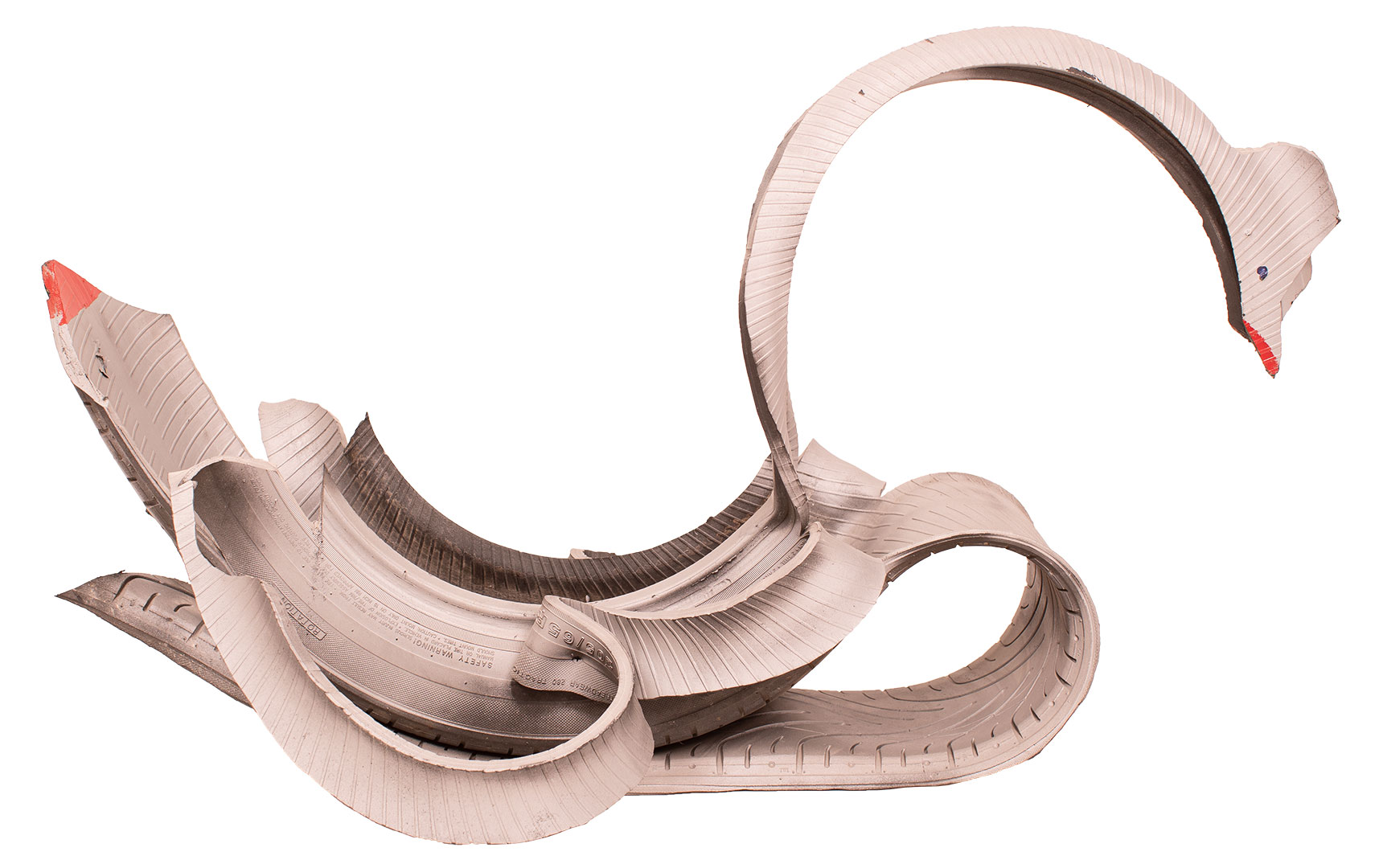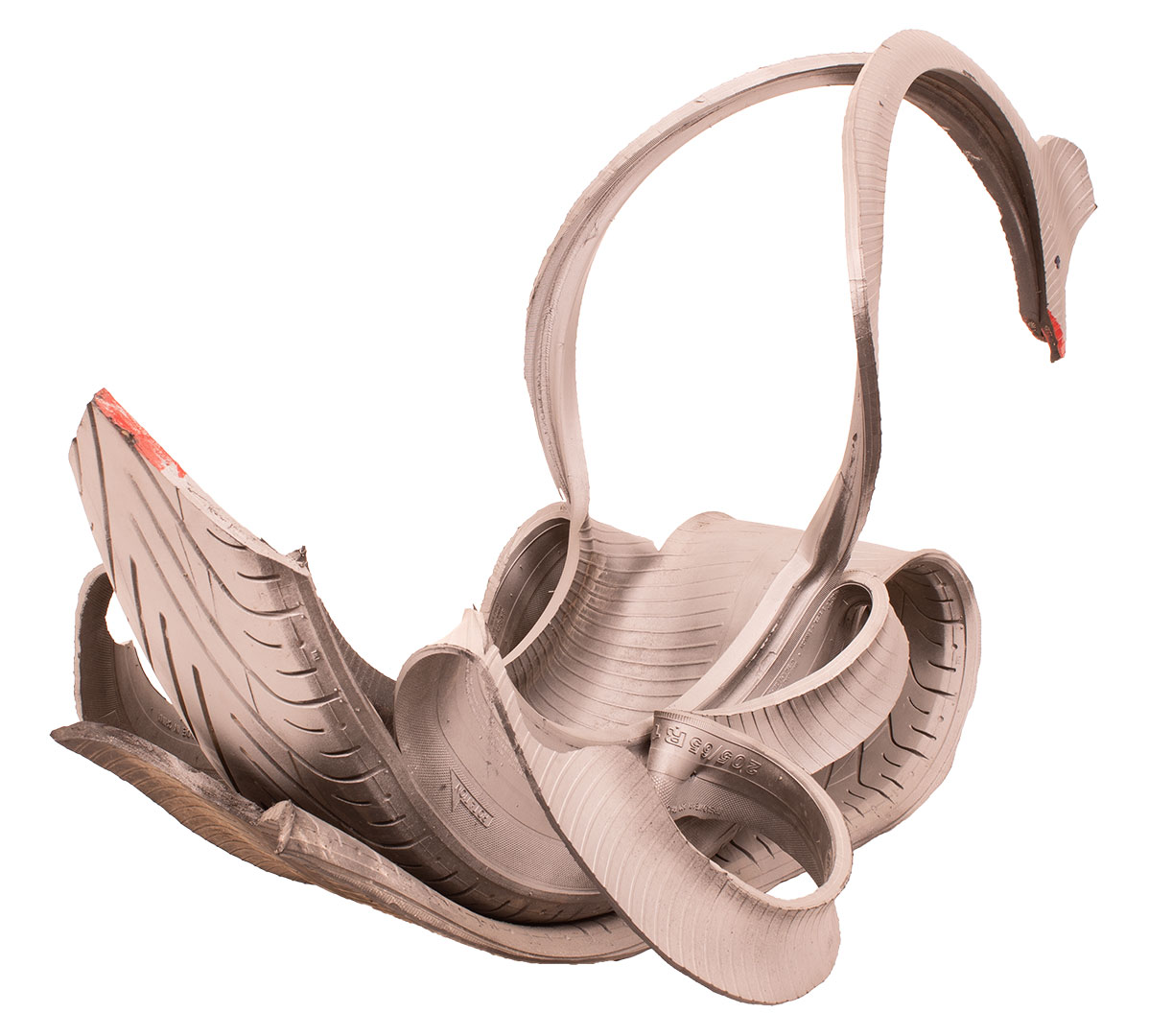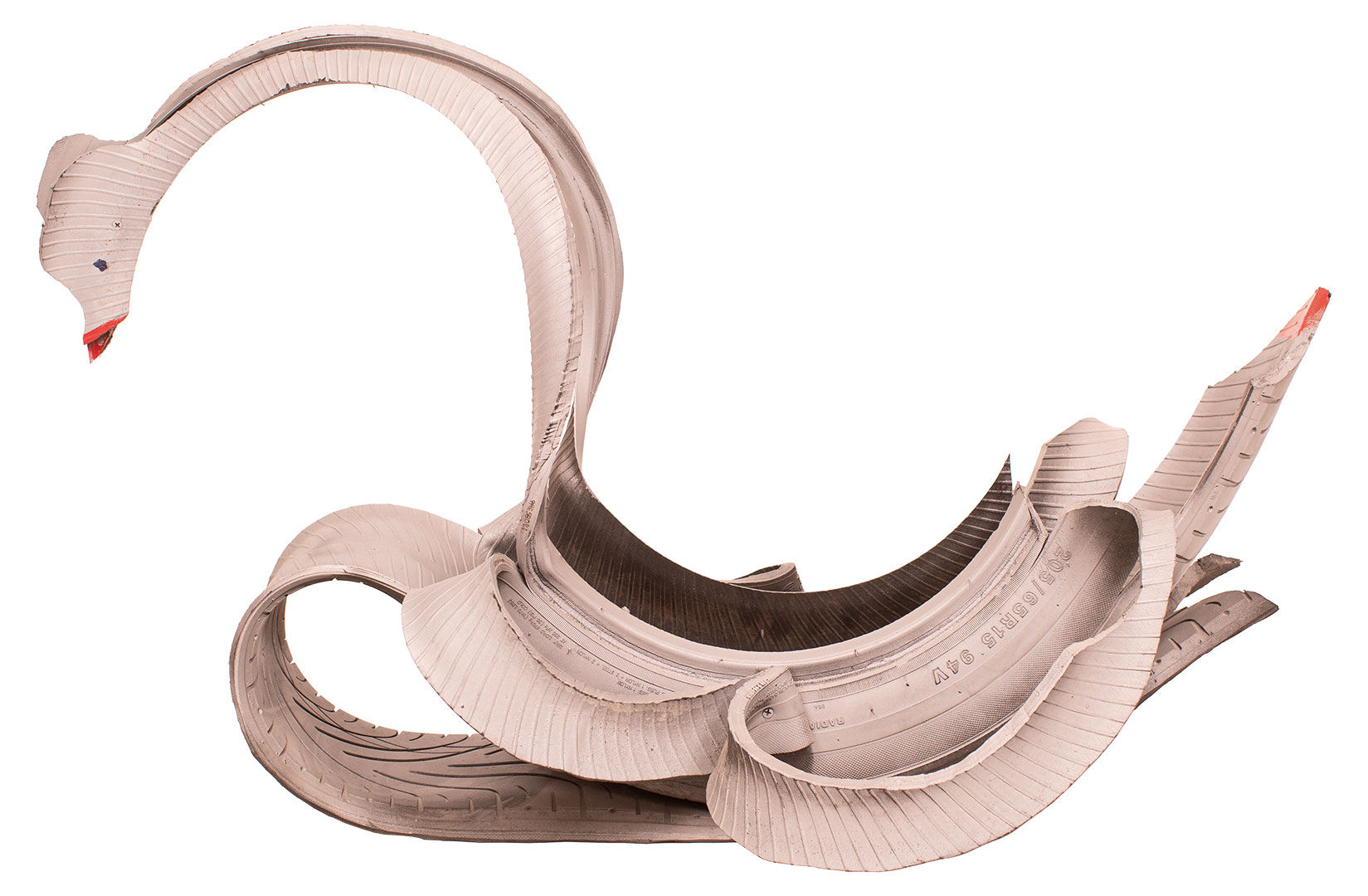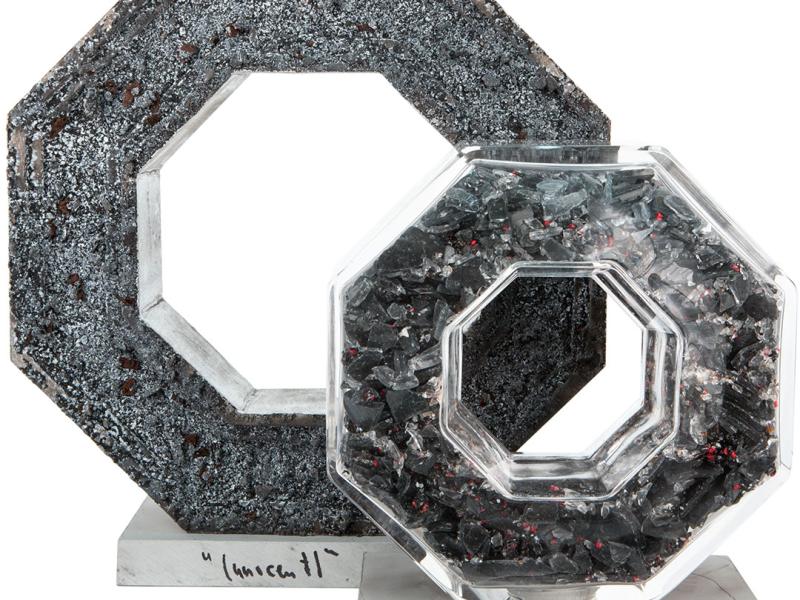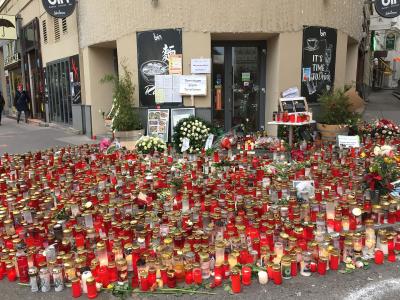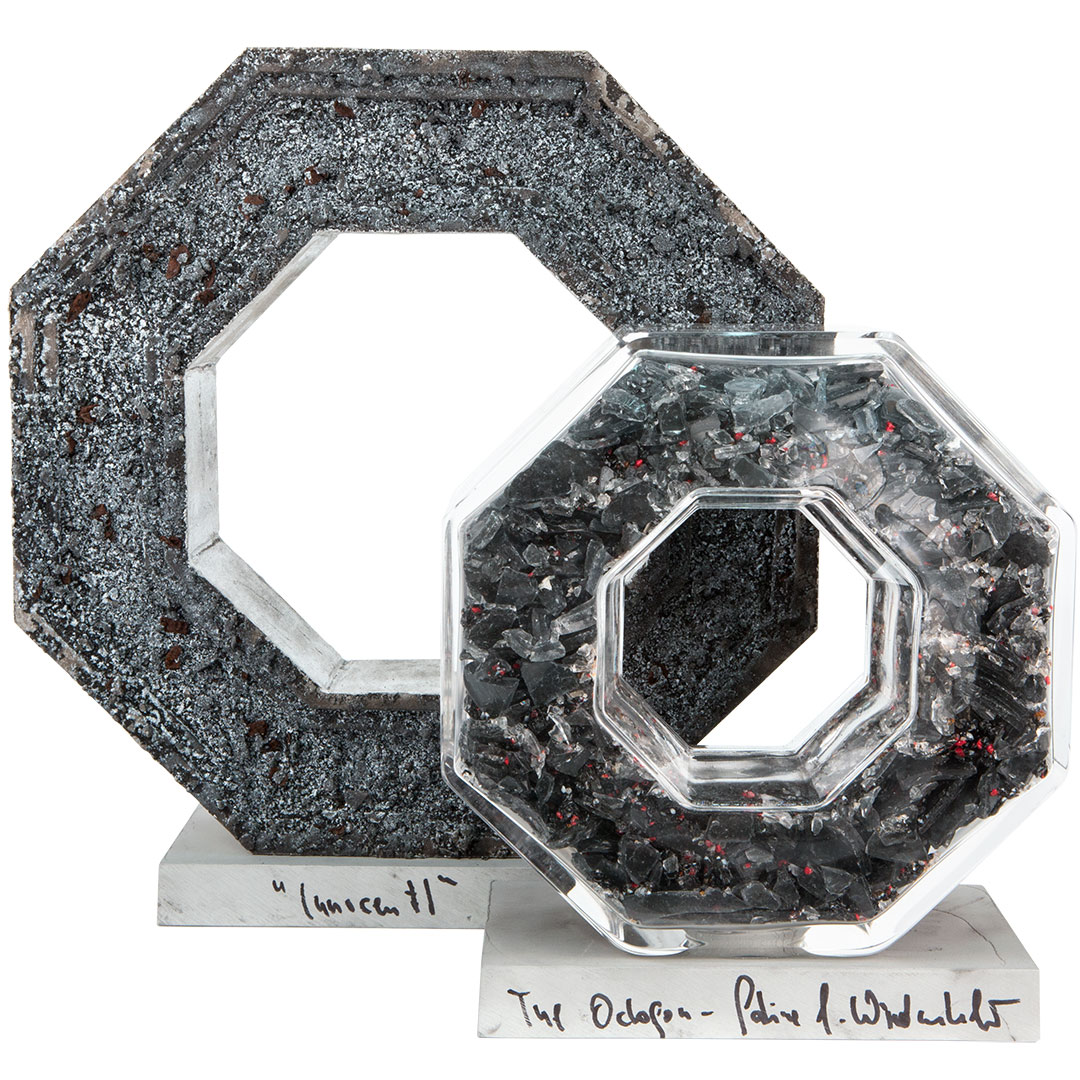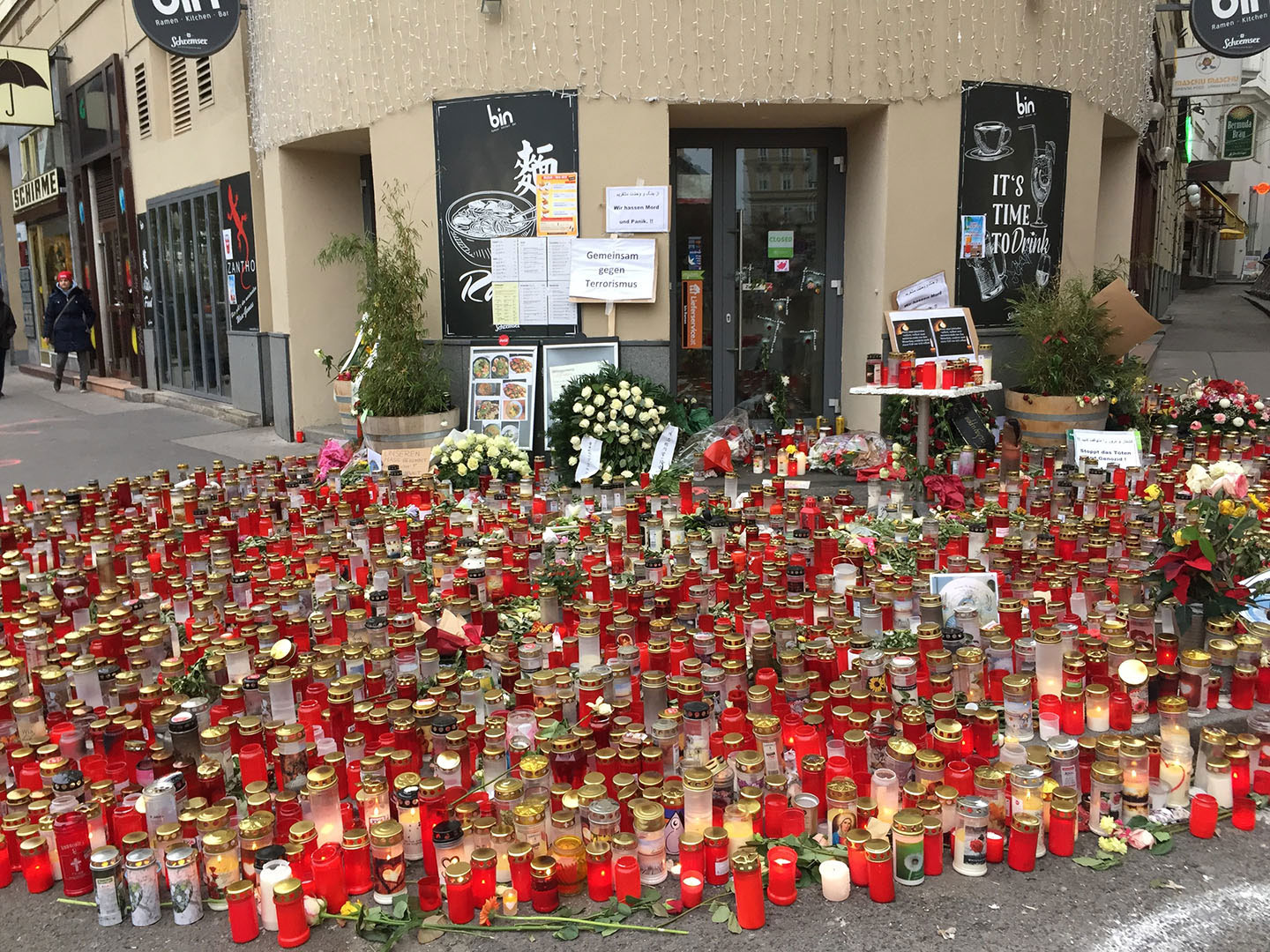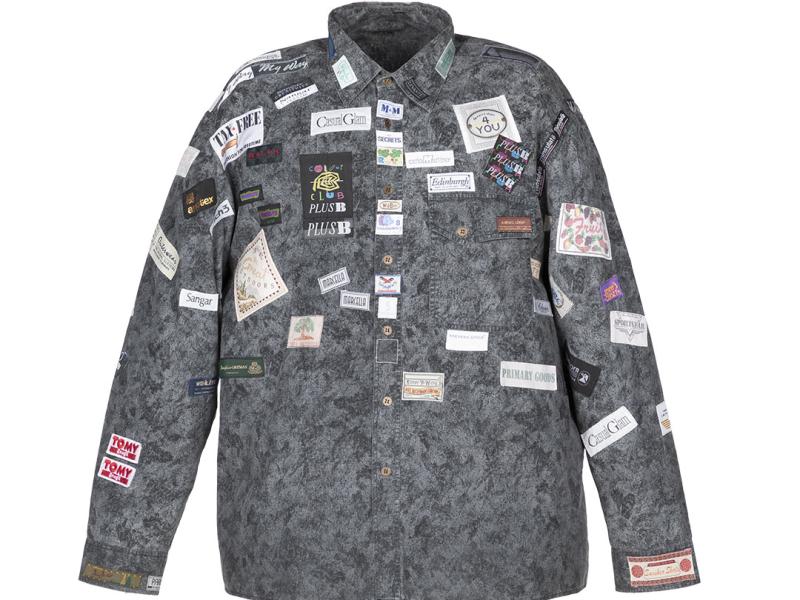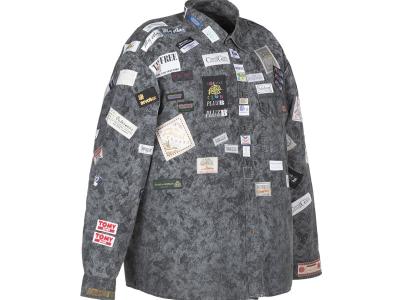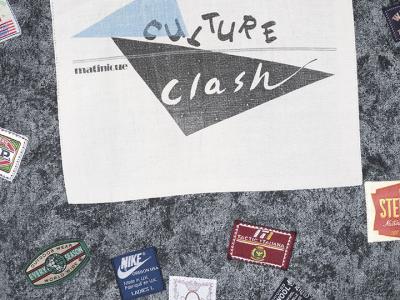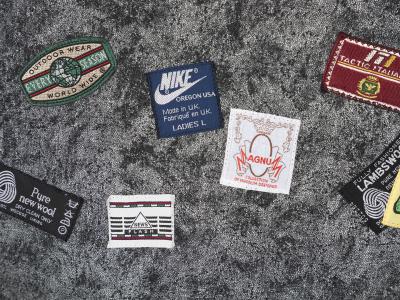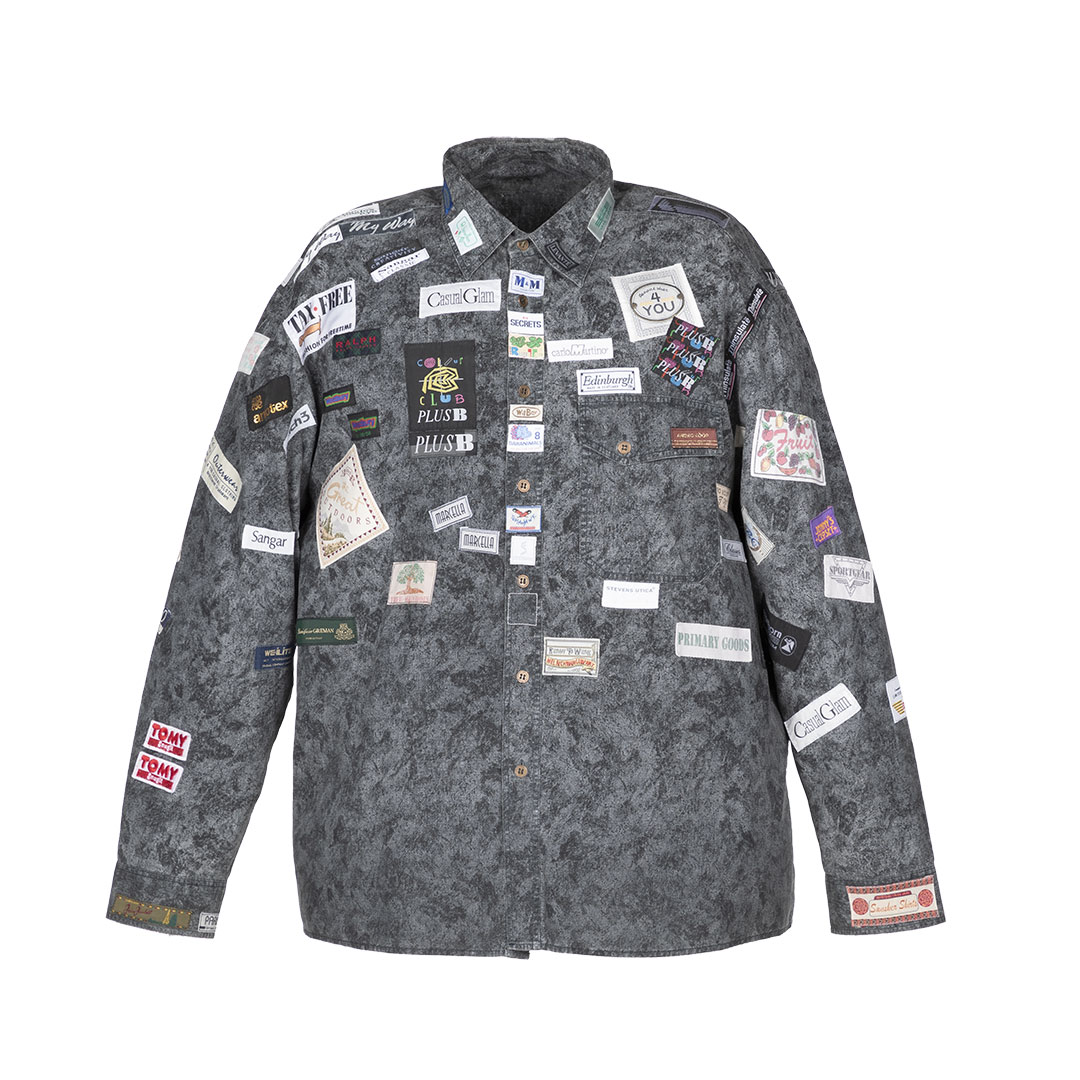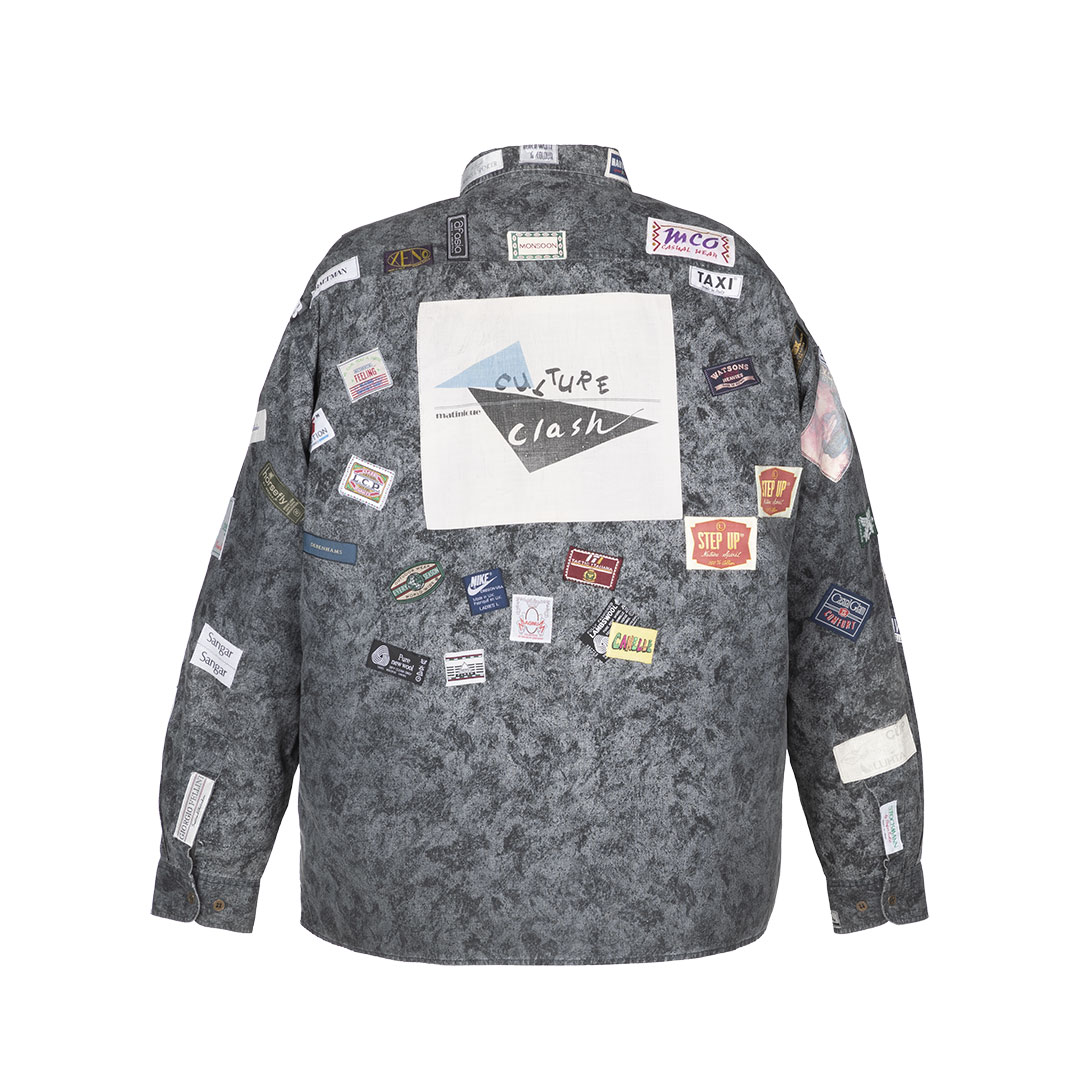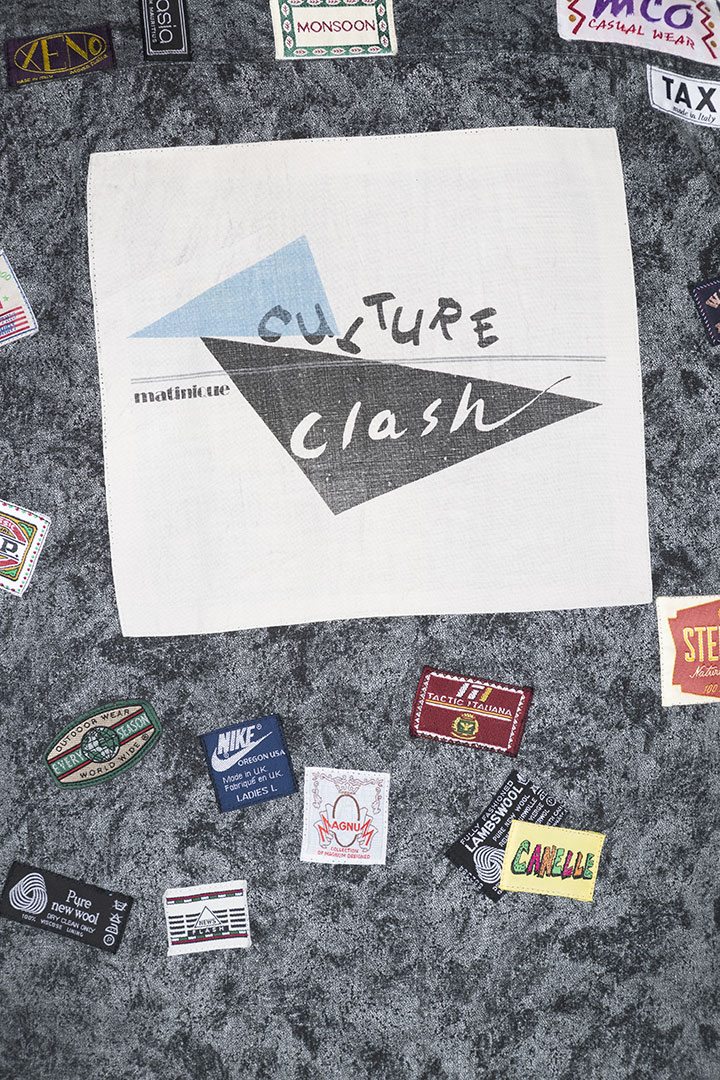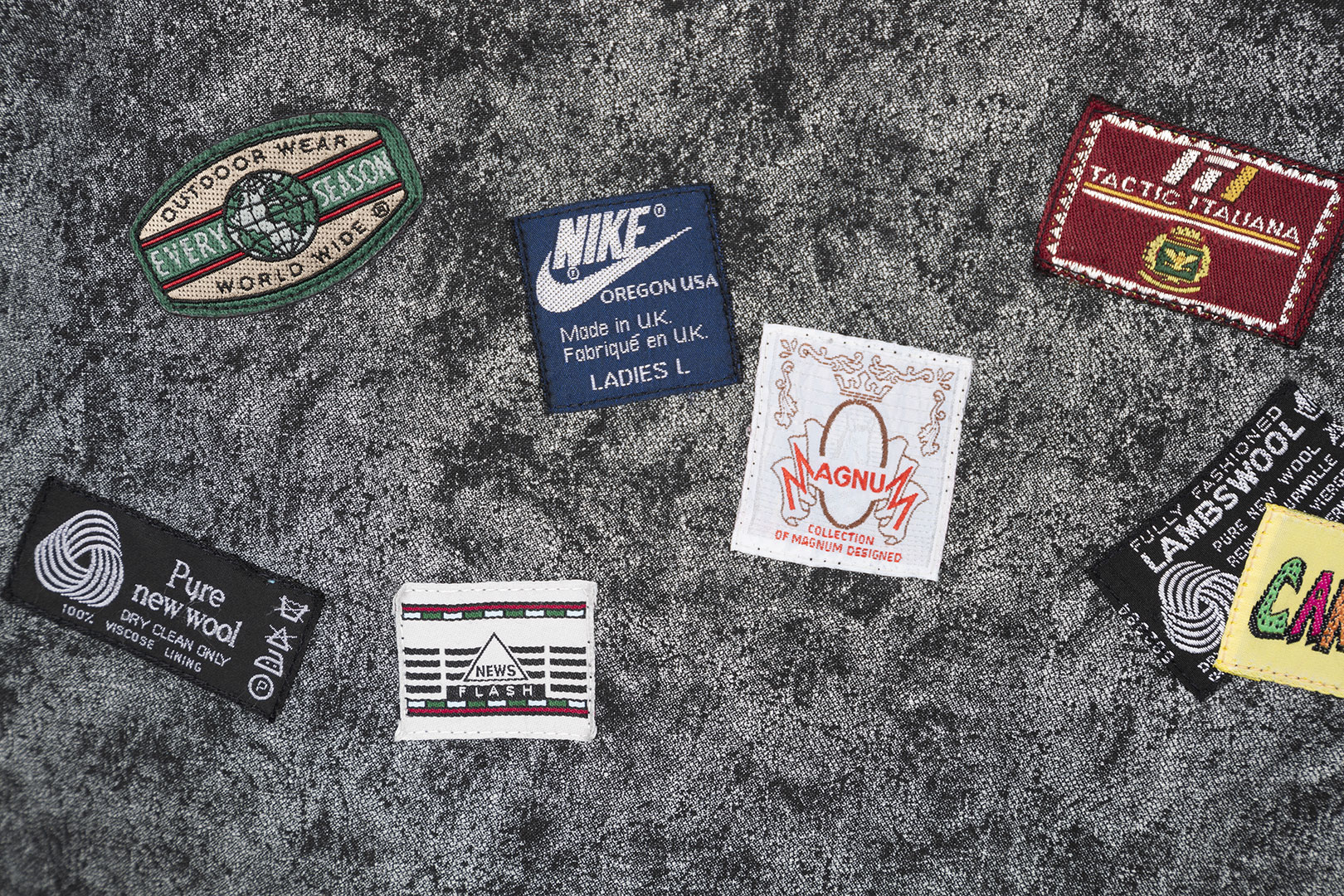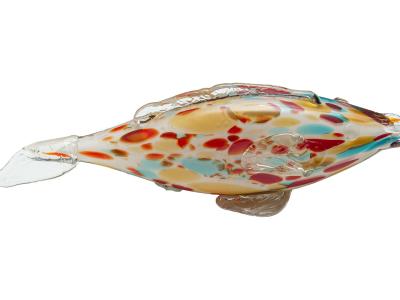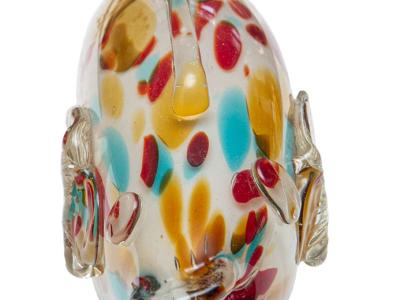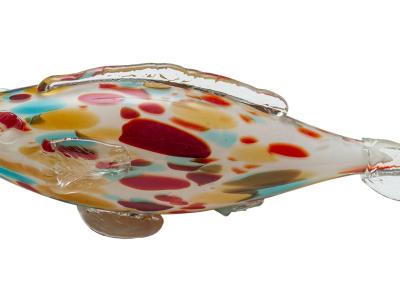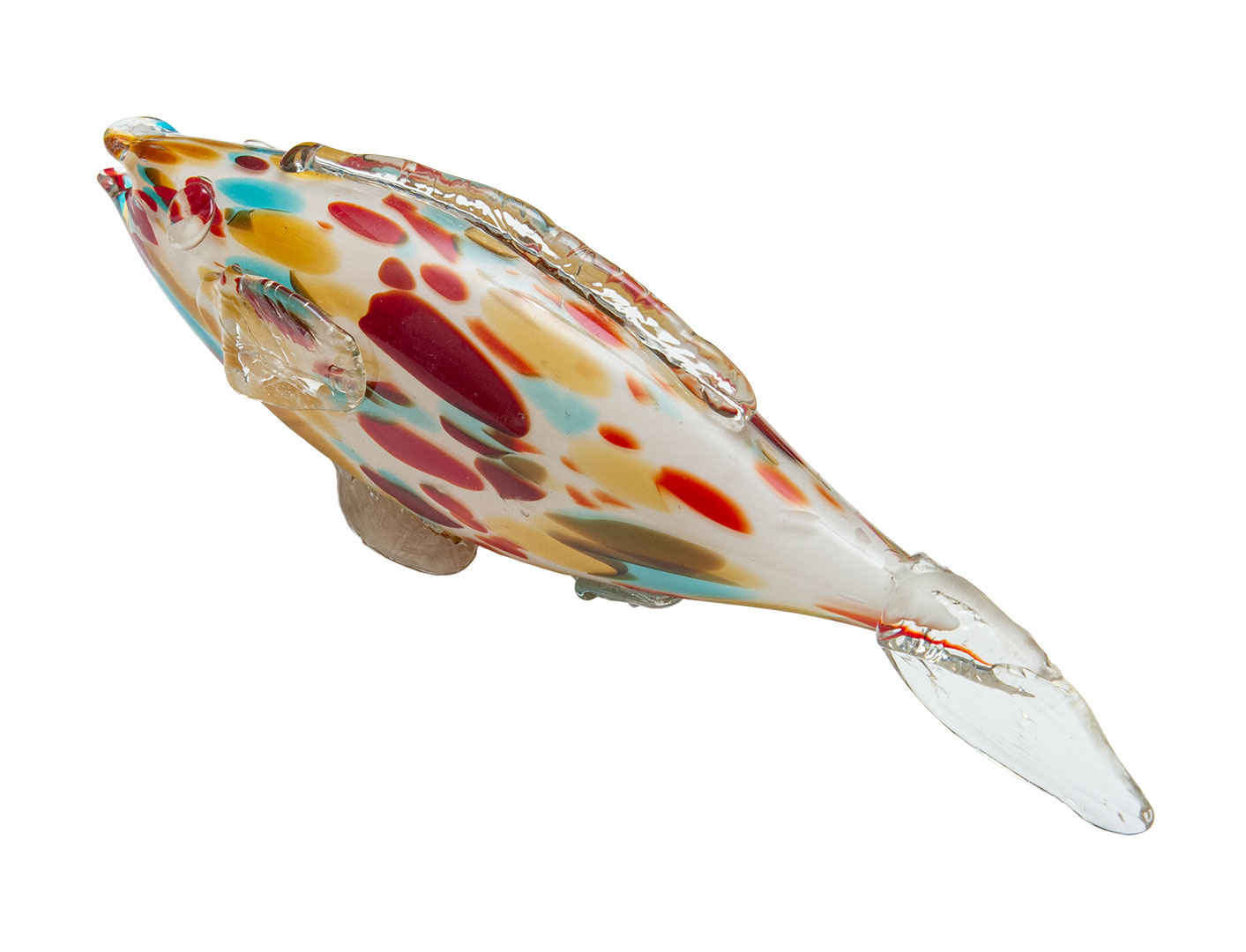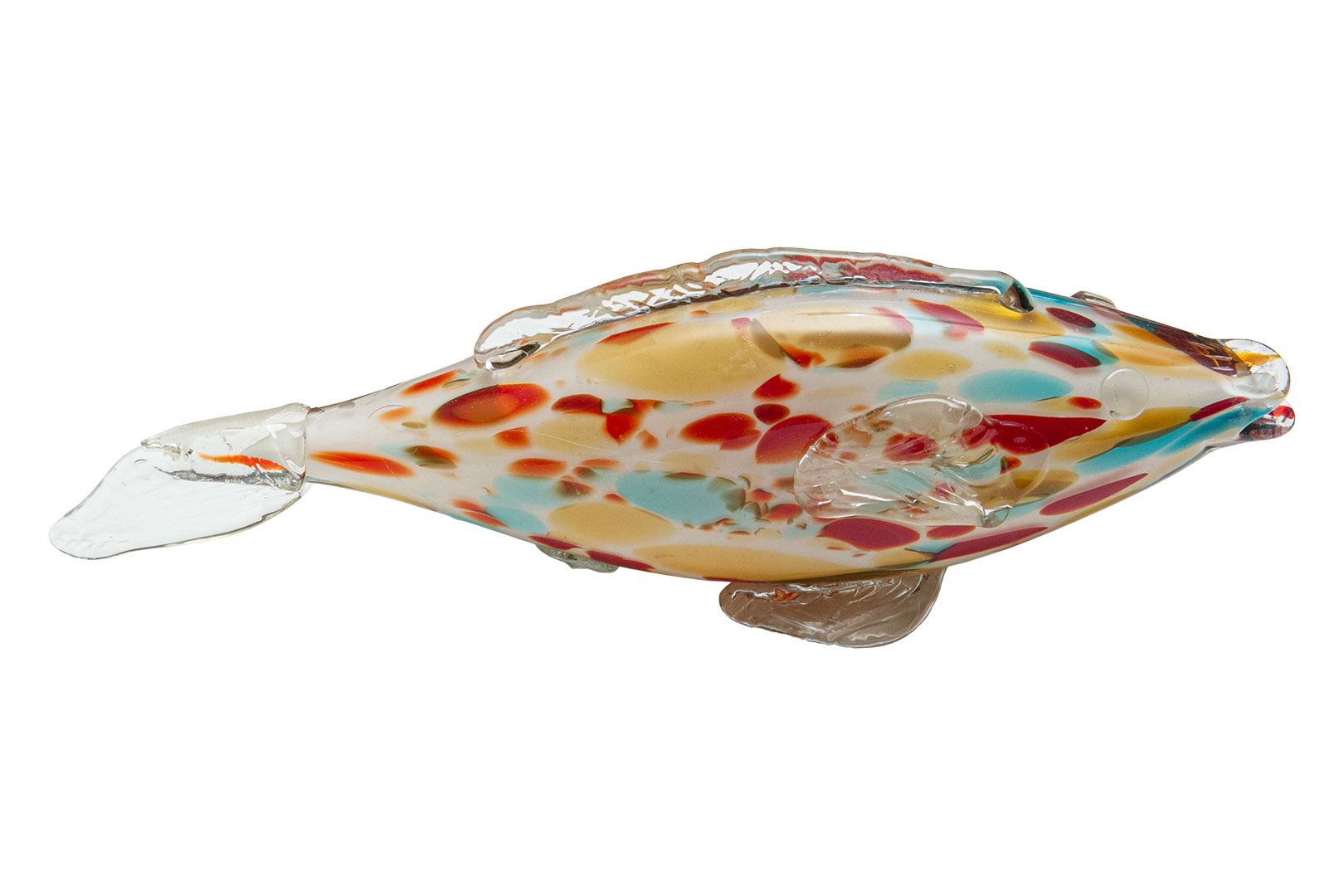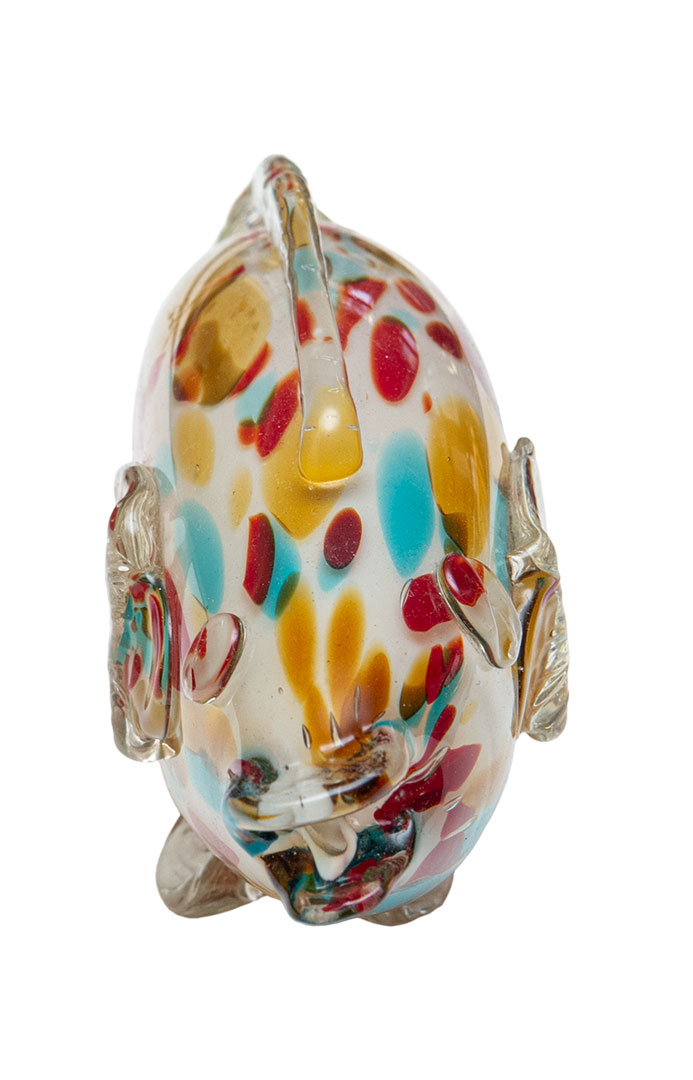Glass craftwork
- Artist / Maker
- Unknown
- Date production / Creation
- 1920-25
- Entry in the museum collection
- 2000
- Place of origin
- Chênée glassworks, Belgium, Europe
- Current location
- Museum of Walloon Life - Province of Liège, Belgium
Waste is part of every industrial process. But the expert eye sees potential in factory scraps.
Horse in blown glass, with decorative elements that have been spun and worked with tongs. A piece created by a glassworker during his leisure time.
This glass horse is a legacy of the blown-glass industry in Liège, which is internationally recognised for its expertise.
Unknown.
In the pause between producing orders glassblowers would practise with scrap pieces of pate de verre glass. Instead of throwing them away, they used their imagination to create glass items known as "bousillé" pieces, like this horse.
Material
Multicoloured blown glass and clear spun glass
Dimension
15 × 6 × 20 cm
Inventory number
5052740
Copyright
Province of Liège – Museum of Walloon Life
Status
In storage
Image credit
Province of Liège – Museum of Walloon Life
Mister Guttalin
- Artist / Maker
- Ettore Guatelli
- Date production / Creation
- Terminus post quem 1990
- Entry in the museum collection
- Terminus post quem 1990
- Place of origin
- Ozzano Taro, Collecchio, Parma, Emilia Romagna, Italy, Europe
- Current location
- Ettore Guatelli Museum foundation, Ozzanno Taro, Italy
A rubbish education has its benefits. How can we learn to learn from our waste?
Mister Guttalin is a figurine that Ettore Guatelli himself crafted by upcycling a used shoe cream tube. It illustrates the way in which something can be forged from nothing. A small personal "work of art" such as this can restore in the hands of its creator the joy of making things – just as children used to do when they would fashion makeshift toys, back when junk offered endless possibilities and could become whatever their imagination conjured up. Guatelli tells us that this is where the fun lays: in taking inspiration from "scrap" and rediscovering the joy of invention.
Through the objects he collected for his museum, Ettore Guatelli, museographer and primary school teacher, devised an educational philosophy based on the direct observation of things – one that we might term "object-based education". In his lessons at primary schools in Ozzano Taro or in the many conference talks he gave, Guatelli would – without realising it – adopt an approach similar to the modern-day method associated with the pedagogy of Bruno Munari and Maria Montessori, placing objects at the heart of his narrative, using them as props to illustrate the value and significance of the stories he was telling.
In the late 1990s, Ettore Guatelli unfortunately fell ill and had to undergo a course of chemotherapy that confined him to his bedroom for a period of convalescence. It was during this time that creations like Mister Guttalin took shape, along with all the figurines he crafted from bits and bobs found in nature or around the home, such as twigs, walnut kernels, bones, pebbles or cork stoppers. Guatelli filled whole drawers, boxes and containers with these small components and, piece by piece, his hands brought to life the mass of miniature people that can now be found on display in the playroom.
Guatelli’s handmade figurines (including Mister Guttalin) are exhibited in the playroom, where they are arranged and displayed side by side on shelves on the right-side wall. The playroom is a special part of the museum, probably because it is this room that tells the story of Guatelli’s research method, where visitors see with their own eyes just what Guatelli was seeking to do: to collect objects from times long gone by through to the distant future. Here we find not only figurines, but other toys too – mills made from walnut shells, pick-up trucks, carousels and miniature aeroplanes – all made by children who would look at a simple piece of wire and imagine a world.
Material
Upcycling a shoe cream tube
Dimension
Cm: Width 5 – height 6 – base diameter 4
Copyright
@Ettore Guatelli Museum Foundation
Status
On display
Image credit
Mauro Davoli
Flowerbed of tyres
- Artist / Maker
- Włodzimierz Podlanowski
- Date production / Creation
- No data/21st century, 2013
- Entry in the museum collection
- 2013
- Place of origin
- Żelazna, Łódzkie Province, Poland, Europe
- Current location
- National Ethnographic Museum in Warsaw, Warsaw, Poland
Some trash may seem beyond redemption. What does it take to uncover its hidden beauty?
At the interface between the space, the self and the tyre, an aesthetic experience is created. The expression of one’s opinion is a matter of perception, indeed of taste. The former is the subject of theory, the latter is something we engage in every day – we either like or dislike something. A flowerbed made from a tyre in a garden can be seen as an independent attempt to solve the problem of troublesome technological waste, while in a museum it provokes a debate on the creation of the collection or on unwanted cultural heritage. Despite recycling being possible, it is easier to throw a tyre into a roadside ditch to grow there with the other fruits of civilisation: fridges, PET bottles and plastic bags. This is indicative of our entrenched objectifying and service-oriented approach to nature, and of our intellectual laziness that exempts us from being in a relationship with space. The slipper flowerbed also gives us an opportunity to reflect on what is worth collecting and how we talk about it?
Tyres buried in the ground as a fence or in the form of a flowerbed, a dog bed, a swing or a sandal can be seen in the four corners of the world. The ways of reusing are innumerable and the creativity of users is unlimited. Our rubber object directly relates to the creation and taming of space and, as such, raises questions about: the limits of the private and the common, the degraded and the ordinary, the object and the non-object, that which can be overlooked and that which is conspicuous, and the Enlightenment division between human and nature.
Ethnographic museums in Poland are in search of identity. They have lost it with the erosion of the rural and folk context. A flowerbed made from tyres obtained at a church fair in a small village can be interpreted in several ways: as an expression of environmental awareness and thinking, which was not characteristic of the folk way of thinking; but also as a contribution to the discussion on what heritage is;
The basic dimension linking the object to the broader concept of waste in this case is reusing and upcycling – reusing and giving a new function to already existing objects. As a spatially taming and aesthetic element, it takes us into the realm of experiencing the world and discussing the values that organise our experiences. Can rubbish have a non-economic value?
Material
Painting, cutting, gluing, car tyre
Dimension
Height 65cm; Length 80cm; Depth approximately 30 cm
Inventory number
PME 58041
Copyright
PME/NEM
Status
On display
Image credit
Photograph by Edward Koprowski
Artwork: ‘The Octogon’
- Artist / Maker
- Sabine Wiedenhofer
- Date production / Creation
- 2021
- Entry in the museum collection
- 2022
- Place of origin
- Vienna, Austria, Europe and Murano, Italy, Europe
- Current location
- Austrian museum of folk life and folk art, Vienna, Austria
Gone but not forgotten: one artist’s plan to immortalise memorial waste.
The Austrian Museum of Folk Life and Folk Art acquired the work in mid 2022. The Viennese artist Sabine Wiedenhofer conceived and created this work in 2021 from the remnants of objects (letters, candles, cuddly toys, etc.) placed spontaneously in remembrance of the terrorist attack of 2 November in District 1 in Vienna. At the time of the Islamist attack, the artist was herself in the streets where the attack took place and took refuge with her family in a café to escape the terrorist's fire. In the days that followed, she visited the sites of the attack on a number of occasions and saw how the objects placed in memory of the victims continued to grow in number. She felt the need to turn these items into permanent works of art.
The Islamist terrorist attack in the bustling city centre of Vienna on 2 November 2020 – on the eve of the start of a new lockdown owing to COVID19 – was a huge shock, the repercussions of which are still being felt today. The residents of the Austrian capital were affected on a personal and emotional level, just like the rest of the Austrian population. Many people knew or know people who had been at the sites of the terrorist attack. This object brings together the experience of the attack, the immediate aftermath and the individual and collective memories of the event and those of the country as a whole, as well as the coping mechanisms deployed, with those of other places in Europe and beyond which have suffered under Islamist terrorism in recent years.
The objects are atypical for the Austrian Museum of Folk Life and Folk Art. The artworks were gifted to the Museum by the artist and the gallery exhibiting her works. The collections of the Austrian Museum of Folk Life and Folk Art mainly contain objects associated with everyday culture and/or folk art and include but a few contemporary works of art. Owing to the particular importance of the attack in terms of the cultural and collective memory of Vienna and Austria as a whole, the Austrian Museum of Folk Life and Folk Art decided to incorporate these objects in the collections and to preserve them in Vienna as resources for further study.
The terrorist attack and spontaneous acts of remembrance in Vienna, such as visiting the sites of the attacks, the placing of letters, candles, cuddly toys and the like, have left their mark. The destruction of these objects of remembrance would have been perceived as a sign of disrespect and desecration not just by the artist but by the municipal department for waste management. The question arose as to how to deal with these special material objects of remembrance, for which there was no (permanent) place in the public space, nor could there be, and which therefore had to be "disposed of". Although they were initially removed and treated as "waste" by the relevant municipal services, the latter subsequently liaised with the artist as to the logistics for dealing with these objects. The transfer of these objects to the Austrian Museum of Folk Life and Folk Art has provided an institutional and museumised framework for this expression of remembrance and for the process of coping and coming to terms with the attack.
Material
Glass, aluminium
Dimension
Glass: 26x26 ; Aluminium: 37x37
Inventory number
ÖMV/89.815/01,02
Copyright
© Volkskundemuseum Wien
Status
In storage
Image credit
© Christa Knott, Volkskundemuseum Wien © Claudia Peschel-Wacha, Volkskundemuseum Wien
Casual Glam
- Artist / Maker
- Re-making by Urve Sinijärv
- Date production / Creation
- Sangar
- Entry in the museum collection
- 1990
- Place of origin
- Private collection
- Current location
- Estonian national museum, Tartu, Estonia
Shirt decorated with brand names and logos.
The object is a fashionable men’s long-sleeved shirt adorned with different logos and brand names, which was worn in the university town of Tartu by poet and writer Karl Martin Sinijärv, who later became the chairman of the Estonian Writers’ Union.
Poet Karl Martin Sinijärv could not remember exactly how he got this shirt: ‘It must have been one of those almost black shirts from the Sangar shirt factory, retailed under the name Casual Glam. At some point in the 1990s, while throwing away another item of clothing, I felt a tinge of guilt and thought I would at least cut off the beautiful label. It felt like a silly thing to do at the time. But then I ended up removing the labels from several other garments and the idea popped into my mind to sew them onto this black shirt in the style of badges. The aim was to glorify and mock the money cult of the 1990s and the desire for a new age. Urve continued to sew labels onto the shirt, leading to a sizeable collection over the years. The shirt even gave rise to redefining a modern science: “If a label denotes a thing and the thing denotes the label, but the thing that the label denoted is, in fact, a completely different thing that in turn has its own label and everything is as mixed up as an upside-down, inside-out shirt, then this is what we call semiotics.” Very typical of the university town of Tartu. At some point the world changed and the shirt embellishing ended. It stayed in the cupboard for a long time. Until the 1990s had become part of history and my son had to find some clothes for a 1990s-style party at school. This is how the shirt found a new lease of life under the sun, which may hopefully carry on in this museum.’ Those with a keen interest in the history of fashion will be able to recognise some of the 1990s brands, which have now gone into the recycling bin of history.
The visuals of very different brands is an intriguing story about the recent history of changes in the European textile industry; about what brands were popular among young people; what designs designers used; and why some of the brands have disappeared from the world market in both Eastern and Western Europe for their environmental footprint; even though this particular men’s shirt was manufactured from quality material in Estonia.
Every year, in cooperation with schools and educational institutions, the Estonian National Museum organises the educational programme ‘Time Travels’ (Ajarännakud) and this shirt gave a student from Tallinn Secondary School of Science a chance to experience life in the 1990s, the period after Estonia regained independence (society in transition, beginnings of private enterprise, new fashion trends, etc.). The shirt as an object has been given to the Estonian National Museum and will enhance the Museum’s permanent exhibition Encounters.
At some point the world changed and the shirt embellishing ended. The shirt had stayed in the parents’ wardrobe for a long time, until the nostalgia for recent history made the 1990s popular again and this garment could be used at a 1990s party.
Those with a keen interest in the history of fashion will be able to recognise many of the popular brands from a couple of decades ago that have now gone into the recycling bin of history.
Material
Cotton
Dimension
Height × Width × Depth: 80 × 50 × 10 cm
Inventory number
ERM A 1066:6
Copyright
Estonian National Museum
Status
Textile storage / collections
Image credit
Estonian National Museum
Blown-glass fish
- Artist / Maker
- Unknown
- Date production / Creation
- C.1960s - 1970s
- Entry in the museum collection
- C.1990s - 2000
- Place of origin
- Unknown, probably Transylvania
- Current location
- National Museum of the Romanian Peasant, Bucharest, Romania
Colourful glass fish created in communist Romania.
This artefact was probably manufactured at one of Romania’s glass-blowing factories, of which there are many in Transylvania, with two of the most popular being at Pădurea Neagră and Tomești. Despite the fact that glass blowing is a profession requiring individual skill and dexterity, these objects were rarely signed by their creators, who generally belonged to glass cooperatives or companies. Under the communist regime, these were managed by a faceless state body designated to act as the sole supplier, and to which the glass-blowers’ work was therefore directly ascribed.
Although the origin of the artefact itself is unclear, we know that glassware was being manufactured in Transylvania from the start of the 7th century, when workers were brought in from Italy, and more specifically from Murano; over time, they were joined by German and Slovak workers. Later on, the Pădurea Neagră and Tomești glassworks opened in Transylvania. From midway through communist times, glass fish would have appeared in most households in Romania. the image that lingers in national mythology is that of such fish sitting next to woven doilies as decorations on cathode-ray tube TVs. Some sources mention that around 90-95 % of the products manufactured were exported to the USA.
The object is part of a larger collection donated by the private donor Marius Cazan. After the revolution which overthrew the communist regime in 1989, the new Museum of the Romanian Peasant announced that it was accepting artefacts from the general public for inclusion in its exhibitions and archives, thus underscoring its role in highlighting everyday history and Romania’s recent past. A great many of these fish came into the museum’s possession for use in exhibitions such as Cei din lume fără nume (2012) and Muzeu3017 (2017).
The artefact is a common object only recently agreed by museums to be of relevance in the light of historical events or high culture. It is not per se a mass-produced object, as the skills of a craftsman were needed for its manufacture. It is more than a domestic item as it reflects the owner’s lifestyle and mirrors a broad spectrum of social attitudes. It encapsulates normal life away from the regime but also shows how ordinary objects could help legitimise power by becoming icons for the regime. Under communism, decorations make luxury democratic and accessible by offering the chance to turn a house into a home; today, such objects are often perceived as kitsch.
Material
Glass blowing
Dimension
30.5 x 10 x 6 cm (L x W x H)
Inventory number
C.Ob-0048
Copyright
National Museum of the Romanian Peasant
Status
In storage
Vladimir Bulza / copyright NMPR
Image credit

